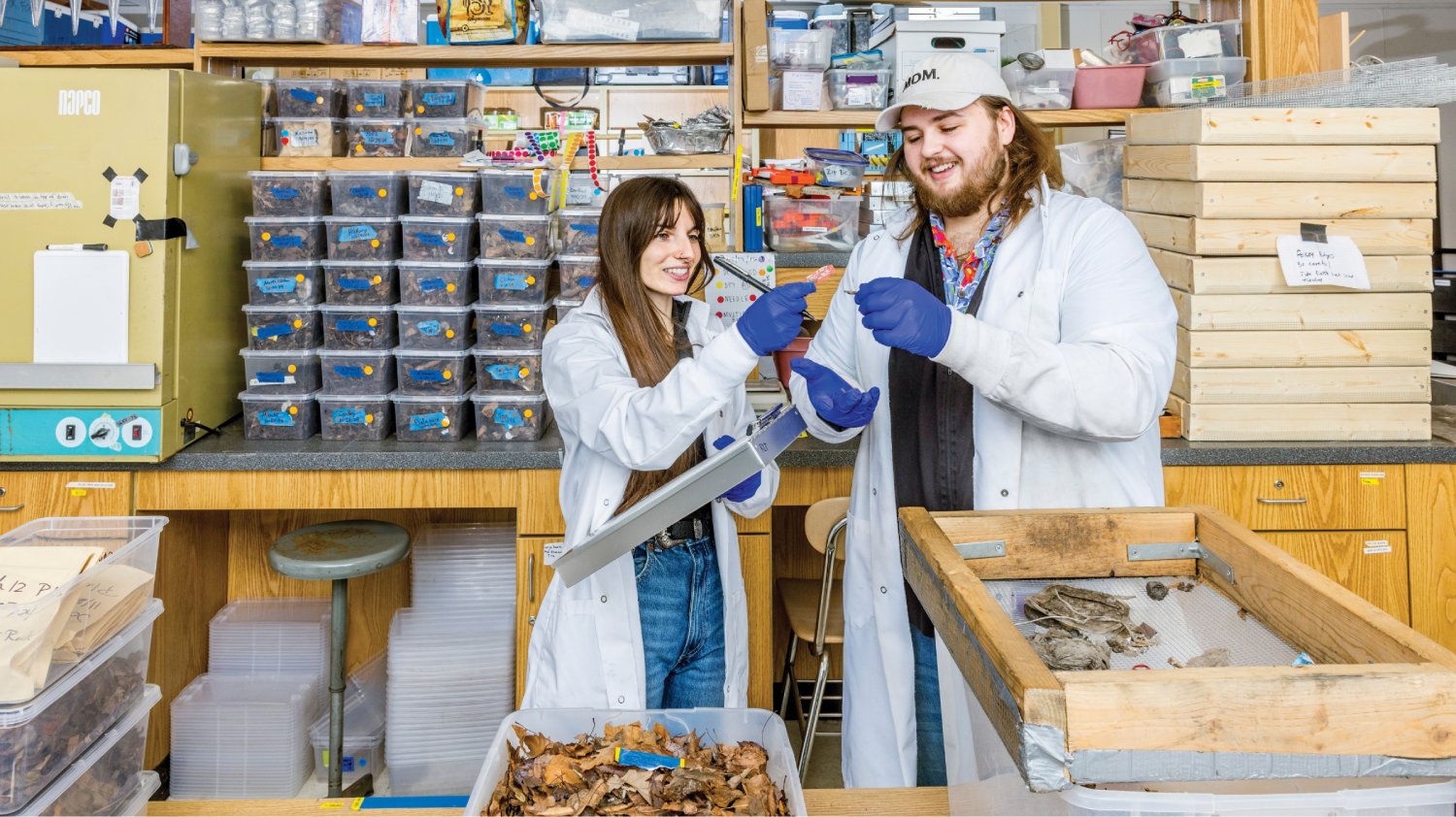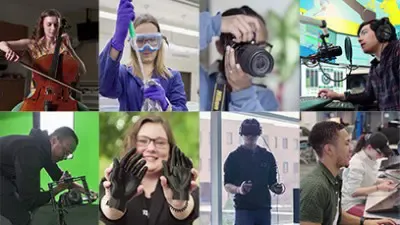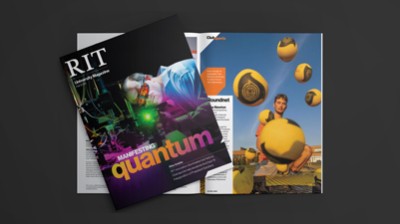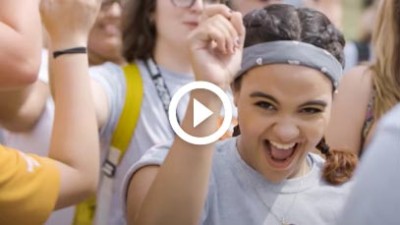Microplastics

A plastic snack wrapper misses a garbage can and floats to the ground. It is then carried by the wind and rainwater into a storm drain, eventually making its way into a nearby lake. After time, this large piece of plastic breaks down into smaller and smaller pieces—so small that it now has the ability to enter a fish that can be caught and become someone’s dinner.
To understand the impact microplastics have on the ecosystem, scientists must first know how plastics enter the environment, how they break down, and what their chemical components are. RIT is part of a team that received nearly $10 million in funding since 2020 to be at the forefront of this research.
Microplastics come from various sources of plastic pollution, most commonly from food wrappers, bottles, bottle caps, bags, straws, and cigarette butts. Waste enters the environment through a number of ways, such as littering, and can be carried to a lake through stormwater. When the materials break down into particles less than 5 millimeters in size, now known as microplastics, they become difficult to detect and mitigate.

With more than 20 percent of the world’s surface freshwater in the Great Lakes, in addition to many smaller lakes, streams, and rivers, the Rochester area is a prime location to try to figure out where most people are exposed to microplastics in the environment.
Matthew Hoffman, professor in RIT’s School of Mathematics and Statistics, used applied mathematics for weather forecasting in the Chesapeake Bay area during his Ph.D. and post-doc years. After coming to RIT in 2011, he became interested in new research about plastic pollution in the Great Lakes.
That interest resulted in several papers with fellow professors and Ph.D. students. He estimated that about 22 million pounds of plastic enters the Great Lakes every year, and a lot of it ends up on the shorelines and at the bottom of the lakes.
“As I became more and more involved in the plastics community, there were so many things that we don’t know, like how plastic changes and how it interacts with the ecosystems,” said Hoffman. “But these are questions I am not equipped to answer as a mathematician.”
At RIT, Hoffman has taught a climate change class with Christy Tyler, professor in the Thomas H. Gosnell School of Life Sciences, whose background is in ecology of coastal systems. Coincidentally, the two are also neighbors and their children are friends. It was a natural collaboration for the two to partner on microplastics research.
“Plastic pollution was a new field, and you need to know a little bit about a lot of things, so we tried to create a group that could fill that gap and try to answer questions that were out of reach for a single person,” said Hoffman.
RIT was the perfect place to tackle this interdisciplinary problem. Hoffman and Tyler added André Hudson, dean of the College of Science; Nathan Eddingsaas, associate professor in the School of Chemistry and Materials Science; and Steven Day, professor in the Department of Biomedical Engineering, to their team. Hudson specializes in biochemistry and microbiology, Eddingsaas examines particles to decipher their chemical makeup, and Day focuses on fluid mechanics.
The strength of the team was recognized immediately with grants and funding, starting with a grant in early 2020 from the National Oceanic and Atmospheric Administration’s (NOAA) New York Sea Grant College Program to examine how plastics are transported, how they are transformed, where they end up, and how they affect the ecosystem of the Great Lakes.
Funding casts a wider net
The COVID pandemic halted a lot of research. Fortunately, having members of the plastics pollution team living in the same neighborhood—and some in the same house (Tyler and Day are married)—allowed the research to continue.
“We’re super lucky, we managed to do a lot of work in smaller lakes and ponds we had access to,” said Tyler. “It turned it into much more of a field project than we had intended.”
The team originally planned to focus only on Lake Ontario but shifted to looking at a number of different types of waterbodies in the Lake Ontario watershed because of
restrictions due to the pandemic. According to Tyler, this turned out to be fortuitous because they found that where plastic enters the environment is important in determining what happens to it and how much risk might be incurred.
Those pandemic findings led to two NOAA Marine Debris Program grants where the team studies how plastics move through communities, waterways, and ecosystems. Using filter devices called Seabins and LittaTraps, the team captures debris in stormwater runoff. The contents are then collected, dried, sorted, and categorized.
The team started by installing nine LittaTraps in the Rochester area and sampling them once a month. Paige Arieno ’23 (environmental science), ’24 MS (environmental science) has been working with the LittaTrap sampling and documentation for more than two years as both an undergraduate and a graduate student.
“I use an instrument that identifies polymers of plastic,” explained Arieno. “There are many polymers. That helps us determine how the different plastics will degrade in the lakes and what effect they will have on animals.”
With support from the National Sea Grant Office and a targeted debris interception program supported by NOAA’s Marine Debris Program, more than 70 new LittaTraps will be installed. The funding also helped build partnerships with local organizations and municipalities to deploy the collection devices around the city of Rochester, leading to the formation of the Community Action for Stormwater CleanUp and Debris Elimination (CASCADE) program.
“We can work on the pollution issue by working with kids and have them develop solutions that they think are going to work in their neighborhoods,” said Tyler. “Education is empowering, and it’s connecting people with nature and showing how they are connected to the bigger ecosystem and are part of the water cycle.”

Even more collaborations came in 2024, starting with the formation of the Lake Ontario Center for Microplastics and Human Health, a research center backed by $7.3 million in funding from the National Institute of Environmental Health Sciences and the National Science Foundation.
The Rochester-based center is codirected by Tyler and Katrina Korfmacher, professor of environmental medicine at the University of Rochester. The collaboration combines RIT’s emphasis on the impact of plastic pollution with UR’s focus on preventing health problems caused by microplastics.
For sustainability Ph.D. student Sydney VanWinkle ’19 (environmental science), ’21 MS (environmental science), the plastics problem is personal. After spending a year in Madagascar as a Fulbright scholar where she evaluated the impact of community based conservation, she found that RIT was the perfect place for her to continue her academic career.
“I’m from Rochester, where our freshwater resources are so vast and so important, and they’re threatened,” said VanWinkle. “All the knowledge that I’ve gained, and how this touches the community, it all really came together. You’re really given the opportunity to be creative and pursue what you think is important through research here at RIT.”

In September, the RIT team was recommended for nearly $1 million in NOAA funding to continue its research intercepting and removing marine debris before it reaches waterways. The team is expanding its storm drain filter research into the neighboring Great Lakes cities of Buffalo and Syracuse.
“Plastics are a way to understand how humans have impacted the Earth. It’s extremely powerful,” said Hoffman. “Making connections in communities that may not be looking at the water, but are connected through stormwater systems, out into the environment, and out into the lake—it’s good for understanding.”

Jayson Kucharek ’23 (environmental science), ’24 MS (environmental science) began working on the project as a student and is continuing as project manager.
He said the community outreach aspect is one of his favorite aspects of the research. “It’s super cool to have a connection with the community and to be able to study these complex issues in a way that’s easy for the public to understand the severity of it,” said Kucharek. “Just one person can make a difference.”
In RIT’s labs, interdisciplinary experts are continuing the work to pinpoint exactly how and where plastics enter the water system. Chemists are also looking at the small particles to determine how plastics break down and what they become. Armed with this information, scientists will then be able to see how microplastics affect human health.
“Microplastics are accumulating in the environment to the point that we can’t ignore it anymore,” said Tyler. “Plastic is in everything we do, everything we touch. Look around. I’m sure there’s probably a lot of plastic right there. It’s everywhere, and we’re exposed to it all the time.”
Learn more
For more on how RIT is studying plastics in the environment, go to rit.edu/plasticpollution.









